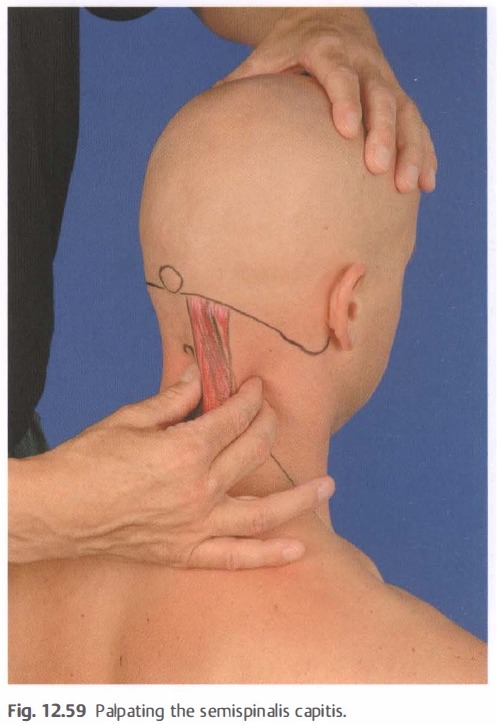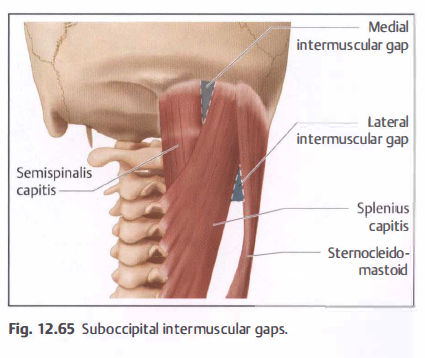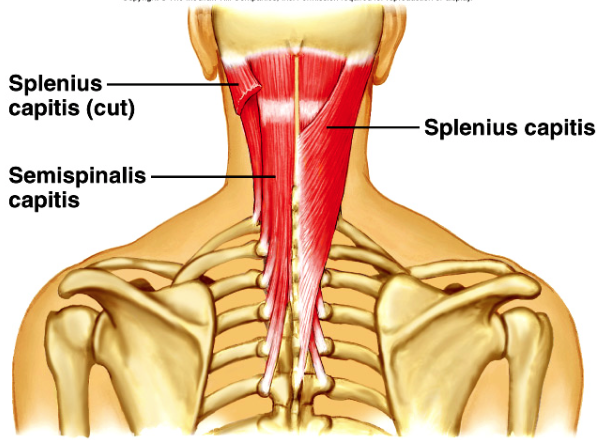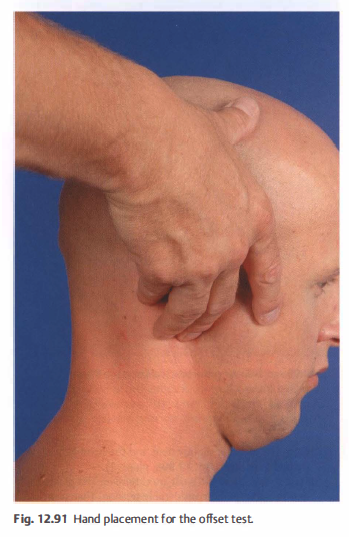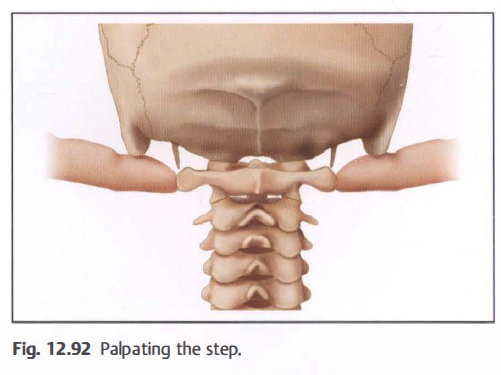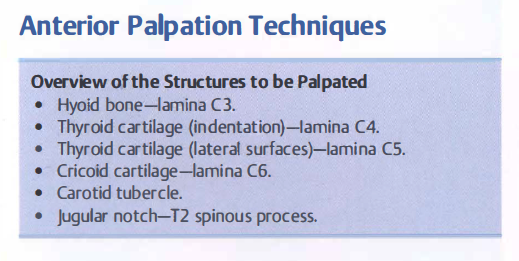
경추부 촉진이 항상 부족하다고 느끼고 있었는데, 그 이유가 이 책을 완벽하게 정리하지 않았기 때문이구나!!
이유없는 것은 없다.. ㅎㅎㅎ
경추의 구조와 생체역학(클릭)을 먼저 읽고
panic bird...
경추 후면부 촉진
기준점 하나. external occipital protuberance
또 하나의 기준점
- 유양돌기, superior nuchal line, c2 spinous process
극돌기-facet joint-transverse process 순서로 촉진
semispinalis capitis
승모근 촉진법
흉쇄유돌근 촉진법
대후두신경, 소후두신경
두판상근(splenius capitis) 촉진
참고) 두판상근(splenius capitis), 경판상근(splenius cervicis), 두반극근(semispinalis capitis), 경반극근(semispinalis cervicis)의 구분
1) 두판상근, 두반극근(semispinalis capitis)
2) 경판상근(splenius cervicis)
3) The semispinalis cervicis (semispinalis colli), arises by a series of tendinous and fleshy fibers from the transverse processes of the upper five or six thoracic vertebrae, and is inserted into the cervical spinous processes, from the axis to the fifth inclusive.
익상인대(alar ligament)의 laxity 검사법
- 우선 논문을 찾아보니, 다운증후군 환자에에게서 흔하게 존재한다
- 어떻게 찾아낼까? 어떤 증상이 나타날까?
- C2 ganglion이 압박되어 나타나는 cervicogenic headache가 있을때?
- 유일한 대안은 muscle이므로 정렬운동이나 잘 시킬까?
지금 통증이 발생하는 경추 퇴행성 디스크의 level찾는법
Identifying the level of Chronically Irritated Intervertebral Disks
Another good example of the use of in vivo anatomy in the posterior cervical spine is an extremely simple test that is used to identify the level of chronically irritated intervertebral disks in patients suffering from persistent neck symptoms ( Fig. 1 2 .68).
The cervical intervertebral disks control the translation movement occurring in the upper vertebra during real extension (tilting the head backward with the chin pulled in). This movement is painful when an intervertebral disk is irritated. The irritated intervertebral disk segment must be located before it can be treated locally.
The principle of this test is to stabilize the lamina of the lower vertebra in the segment and conduct real extension above this point.
Aim
To locate the irritated segment.
Criteria
Patient reporting pain.
Procedure
Starting at the (2 spinous process, the lamina of C2 is located, followed by the lamina of C3. This is the first intervertebral
disk segment. Both thumbs are placed flatly over the laminae. They hold onto the laminae tightly and by applying pressure in an anterior direction they prevent movement in a posterior direction. The patient extends the lower cervical spine by tilting the head backward and pulling the chin in (real extension).
C3 cannot move as it is fixed by the thumbs. Extension only takes place at the (2/(3 level. If the test is negative, the next inferiorly located laminae are stabilized and the test is repeated.
Interpretation
The test is positive and the segment found when the patient indicates their typical type of pain. The test is expected to be positive in the lower i ntervertebral disk segments, if anywhere, as these segments, similar to the lowermost lumbar segments, are expected to suffer from intervertebral disk degeneration more often.
기능적 마사지 테크닉
1) paravertebral functional massage
기능적 massage를 위한 V-grip
경추 측면촉진
하악골 촉진
C1횡돌기 촉진
C2-3횡돌기 촉진
The position of the transverse processes must be viewed in relation to the sternocleidomastoid in particular. The C1 transverse process is found anterior to the sternocleidomastoid, the C2 transverse process directly beneath the muscle, and the C3 transverse process more posterior to the muscle belly ( Fig. 1 2.71 ). The shape expected to be felt is also crucial :
- 경추 횡돌기는 SCM과 관련지어서 촉진해야 함.
- C1 횡돌기는 SCM앞쪽에서, C2 횡돌기는 SCM의 바로 아래, C3 횡돌기는 SCM근복의 좀더 뒤에서 촉진할 수 있음.
• The C1 transverse process is very long and varies greatly in length and form. In rare cases it can point posteriorly or be positioned close to the occiput. The variation in shape and length of the transverse process can lead to incorrect conclusions being made when comparing sides using palpation. Making a diagnosis based on the position of structures alone is therefore very unreliable.
• All transverse processes inferior to and including C2 tend to be shorter. It is therefore expected that when the palpating finger moves down from the tip of the C1 transverse process it will slide deep into the tissue until the transverse process of C2 is reached. Again, topographical anatomy and expectations related to consistency and shape form the foundations for precise palpation.
- C1 횡돌기는 길고, 나머지 경추 횡돌기는 짧아짐.
- 그래서 C1횡돌기에서 아래로 내려오면서 촉진할때 살짝 기울어져 있음.
흉쇄유돌근을 뒤에서 밀고 C3횡돌기 촉진하는 법
Posterior triangle of the neck
흉쇄유돌근 촉진법
쇄골-승모근 경계
occipital triangle of the neck의 근육들
전사각근과 후사각근
brachial plexus
- 촉진은 항상 치료와 함께 하는 것이 좋다.
- 신경스트레칭과 함께...
The branches of the brachial plexus can be palpated in the area surrounding the artery and immediately superior to it. These thin strands can be felt using a transverse palpation, even without the use of extra aids. When the branches have been correctly located, they can typically be rolled back and forth underneath the palpating finger, similar to the plucking of a very loose guitar string.
C1 움직임(offset test)
Palpation during Movement at C1 ("Offset")
The localization of the C1 transverse process can be used in several ways for assessment. The following section describes how to feel movement at the atlas during upper cervical lateral flexion. These movements have already been mentioned in the section "Biomechanics of the Upper Cervical Spine" above, page 326.
- C1횡돌기 위치를 찾는 방법은 몇가지가 있음. 앞에서 설명한 방법은 경추신전하면서 찾는 방법
When the cervical spine laterally flexes, the atlas moves a few millimeters toward the side of lateral flexion. This offset can be assessed using palpation and provides information on the normal pattern of movement at the atlas that is expected when lateral flexing to both sides.
- 경추 측굴시 C1은 함께 움직임. 이러한 보상움직임을 촉진하면서 촉진할 수 있음.
The test is based on the palpation of a step between the tip of the C1 transverse process and the lateral end of the mastoid process. To achieve this, the middle finger of both hands must find this step and feel its size. The therapist places the tips of the middle fingers on the side of the tips of the transverse processes. The thumbs rest on the side of the head to stabilize this position ( Fig. 1 2.91 ).
- 이 검사는 유양돌기의 끝과 C1 횡돌기의 관계에 기초함. 그림과 같이 두번째 손가락을 C1횡돌기에 두고 촉진함. 손가락은 머리를 안정화함.
The finger pads come into contact with the posterior aspect of the mastoid process and feel the distance between the tip of the transverse process and the side edge of the mastoid process ( Fig. 1 2.92).
- 손가락을 유양돌기 뒤에 닿고, 유양돌기 끝과 횡돌기 끝사이의 거리를 느낌.
-
Aim
To assess mobility in the atlantooccipital joints (CO/C1 ).
Criteria
Change in the size of the step following positioning in lateral flexion to the same side.
Procedure
• Phase 1: palpating the size of the step in a neutral SP. It is important that the upper cervical spine is positioned in a completely neutral position ( Fig. 1 2.93a, phase 1).
• Phase 2: the head is moved into maximal upper cervical lateral flexion and the size of the step is palpated once again ( Fig. 1 2.93b, phase 2).
- 그림과 같이 중립자세에서 C1횡돌기를 촉진하고, 머리를 좌우로 측굴하면서 찾음.
- C1횡돌기가 위 그림과 같이 크기 때문에 쉽게 촉진할 수 있음.
Interpretation
When mobility at the atlantooccipitaljoints is normal, the step is expected to decrease in size. If no difference can be observed between the size of the step before and after lateral flexion, this is an indication of a hypomobile segment. With normal mobility, it is also expected that the size of the step on the other side will decrease when laterally flexing in the opposite direction. It can only be assumed that the mobility ofCO/C1 is normal when both offset tests demonstrate a decrease in step size. If the offset does not decrease in one or both of these tests, the side of restricted mobility must be documented.
Offset 검사에서 커다란 C1횡돌기-- 작은 C2횡돌기
- 이 기울어짐, 작아짐이 느껴지지 않으면 상부경추의 과운동성이거나 저운동성을 암시하는 것임.
경추부 전면부 촉진
따로 정리함...










